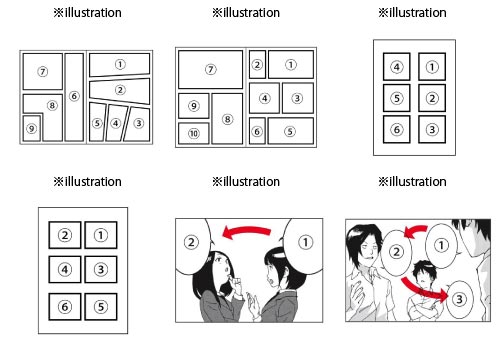It is described in one word, Komawari, but it's not quite that simple. When doing that, it is necessary to consider various elements.
Position, size and shape of frame
Positional relationship between composition, angle, characters and so on
Size, position and shape of speech balloon
Size, position and shape of onomatopoeic words
Consider the following when doing Komawari, <Basic>
-A page is read on from top to bottom and from right to left.
-Big frame stands out.
-Think about doing Komawari by double-page. What readers see at first is double-page.
-In a frame, one reads from top to bottom and from right to left. So, speech balloons are also read in this order and motions of characters are seen from this order.
-Space between each frames: narrower one is first and broader one is last.

Japanese
第10回 マンガをつくる -コマ割りに必要な要素-
コマ割りと一言で言いますが、その中には実に様々な要素を複雑にからめて考えます。
- コマの位置・コマの大きさ・コマの形構図・アングル・人物などの位置関係
- フキダシの大きさ・位置・形
- 擬音の大きさ・位置・形
- これらの要素を関連づけながら、より効果的な「コマ割り」を考えて行きます。
- 更に、ページごとの構成や、ストーリーに関連しての山場作りなども考える必要があります。
コマ割りする時に考えておくこと<基本>
- ページの中では、上から下、右から左の順で読まれる。
- 大きなコマは強く目立つ。
- コマ割りは見開き(2ページ)単位で考える。
- 本を読む読者には、見開き2ページが目に入る。
- 1コマの中でも、上から下、右から左の順で目が行く。
- フキダシはこの順で読まれる。
- 人物なり動きは、この順で見られる。
- コマとコマのすき間(間白)は、細い方が先、太い方が後。

Written by Lucky Uematsuillustration;honda-toyotaTranslated by zmi

